
Chrzanów
Encyclopedia
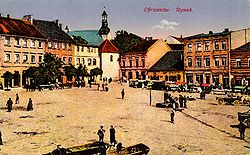
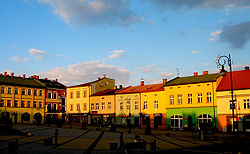
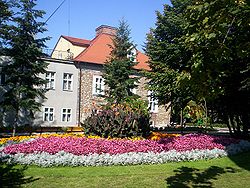
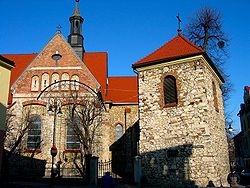
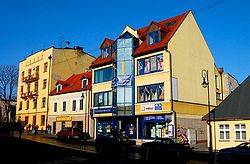
Poland
Poland , officially the Republic of Poland , is a country in Central Europe bordered by Germany to the west; the Czech Republic and Slovakia to the south; Ukraine, Belarus and Lithuania to the east; and the Baltic Sea and Kaliningrad Oblast, a Russian exclave, to the north...
with 39,704 inhabitants (2006). It is situated in the Lesser Poland Voivodeship
Lesser Poland Voivodeship
Małopolska Voivodeship , or Lesser Poland Voivodeship, is a voivodeship, in southern Poland...
(since 1999) and is the capital of Chrzanów County
Chrzanów County
Chrzanów County is a unit of territorial administration and local government in Lesser Poland Voivodeship, southern Poland. It came into being on January 1, 1999, as a result of the Polish local government reforms passed in 1998. Its administrative seat and largest town is Chrzanów, which lies ...
.
To 1809
It is impossible to establish reliable date of the foundation of the town. On the site of the town a stronghold existed. Later it was raised to the rank of a castellanyCastellany
A castellany was a district administered by a castellan.Castellanies appeared during the Middle Ages and in most current states are now replaced by a more modern type of country subdivision....
. The earliest documents which corroborate the existence of Chrzanów castellany come from the late 12th century when in around 1178 Chrzanów castellany was annexed to Silesia
Silesia
Silesia is a historical region of Central Europe located mostly in Poland, with smaller parts also in the Czech Republic, and Germany.Silesia is rich in mineral and natural resources, and includes several important industrial areas. Silesia's largest city and historical capital is Wrocław...
by order of Duke Casimir II the Just
Casimir II the Just
Casimir II the Just was a Lesser Polish duke at Wiślica during 1166–1173, and at Sandomierz since 1173. He became ruler over the Polish Seniorate Province at Kraków and thereby High Duke of Poland in 1177; a position he held until his death, interrupted once by his elder brother and predecessor...
. In the second half of the 13th century, however, it was reunited with the Duchy of Kraków
Kraków
Kraków also Krakow, or Cracow , is the second largest and one of the oldest cities in Poland. Situated on the Vistula River in the Lesser Poland region, the city dates back to the 7th century. Kraków has traditionally been one of the leading centres of Polish academic, cultural, and artistic life...
. In 1241 the wooden stronghold of Chrzanów was put to the torch by Mongol hordes invading Poland
Poland
Poland , officially the Republic of Poland , is a country in Central Europe bordered by Germany to the west; the Czech Republic and Slovakia to the south; Ukraine, Belarus and Lithuania to the east; and the Baltic Sea and Kaliningrad Oblast, a Russian exclave, to the north...
from the east. The town of Chrzanów was built according to the Magdeburg Law in the mid-14th century under the reign of King Casimir III the Great, however, nothing proves that it was surrounded by defence walls. It is believed that Chrzanów was an open town. The local church was mentioned for the first time in documents in the tax-register of Peter's Pence
Peter's Pence
Peter's Pence is payment made more or less voluntarily to the Roman Catholic Church. It began under the Saxons in England and is seen in other countries. Though formally discontinued in England at the time of the Reformation, a post-Reformation payment of uncertain characteristics is seen in some...
, 1325-1328. Since the time of its construction in the 14th century until 1640 the town was the property of the Ligęza family of the Półkozic coat of arms. In mid-15th century Chrzanów had c. 430 residents and in the 17th c. some 650. At least from the early 15th c. a parish school existed by Chrzanów's Church of St Nicholas.
In the 16th century King Sigismund II Augustus
Sigismund II Augustus
Sigismund II Augustus I was King of Poland and Grand Duke of Lithuania, the only son of Sigismund I the Old, whom Sigismund II succeeded in 1548...
of Poland bestowed a new privilege on the town, allowing for 4 extra fairs. Various guilds were active in the town: weavers', tailors', shoemakers', smiths', butchers' and others. Ancient Chrzanów's speciality was trading cattle, as here was a customs house for exports of cattle to Silesia
Silesia
Silesia is a historical region of Central Europe located mostly in Poland, with smaller parts also in the Czech Republic, and Germany.Silesia is rich in mineral and natural resources, and includes several important industrial areas. Silesia's largest city and historical capital is Wrocław...
and ore trade which was mined and smelted by Chrzanów's burghers. In 1640 Chrzanów was taken over by Andrzej Samuel Dembiński. Then in 1649 it was inherited by his granddaughter Katarzyna Grudzińska, and in 1675 by the Stadnicki family. In 1731 it went to Józef Kanty Ossoliński. In 1654 King John II Casimir
John II Casimir of Poland
John II Casimir was King of Poland and Grand Duke of Lithuania during the era of the Polish–Lithuanian Commonwealth, Duke of Opole in Upper Silesia, and titular King of Sweden 1648–1660. In Poland, he is known and commonly referred as Jan Kazimierz. His parents were Sigismund III Vasa and...
bestowed upon Chrzanów the privilege of holding extra fairs and in 1781 a similar privilege was bestowed on the town by King Stanislaus II Augustus. The second halv of the 17th c. was a particularly hard period for Chrzanów. As a result of wars waged at the time the town was looted on several occasions by the Swedes (1655–1657), the Austrians who fought against them (1657), by Transylvanian troops of Prince George Rákóczi and by Polish troops as well. During the Great Northern War
Great Northern War
The Great Northern War was a conflict in which a coalition led by the Tsardom of Russia successfully contested the supremacy of the Swedish Empire in northern Central Europe and Eastern Europe. The initial leaders of the anti-Swedish alliance were Peter I the Great of Russia, Frederick IV of...
Chrzanów was plundered and put to the torch by Swedish troops of King Charles XII
Charles XII of Sweden
Charles XII also Carl of Sweden, , Latinized to Carolus Rex, Turkish: Demirbaş Şarl, also known as Charles the Habitué was the King of the Swedish Empire from 1697 to 1718...
. During the Polish-Russian war which broke out in 1792, Chrzanów was occupied by Russian (1792–1793) and Prussian troops (1793–1795). In 1795, following the third partition of Poland-Lithuania, Chrzanów was annexed to Galicia in the Habsburg Empire
Habsburg Monarchy
The Habsburg Monarchy covered the territories ruled by the junior Austrian branch of the House of Habsburg , and then by the successor House of Habsburg-Lorraine , between 1526 and 1867/1918. The Imperial capital was Vienna, except from 1583 to 1611, when it was moved to Prague...
.
1809-1918
In the period 1795-1809 Chrzanów was a part of Austrian GaliciaKingdom of Galicia and Lodomeria
The Kingdom of Galicia and Lodomeria was a crownland of the Habsburg Monarchy, the Austrian Empire, and Austria–Hungary from 1772 to 1918 .This historical region in eastern Central Europe is currently divided between Poland and Ukraine...
. In 1809, as a result of the war between Austria
Austrian Empire
The Austrian Empire was a modern era successor empire, which was centered on what is today's Austria and which officially lasted from 1804 to 1867. It was followed by the Empire of Austria-Hungary, whose proclamation was a diplomatic move that elevated Hungary's status within the Austrian Empire...
and the Duchy of Warsaw
Duchy of Warsaw
The Duchy of Warsaw was a Polish state established by Napoleon I in 1807 from the Polish lands ceded by the Kingdom of Prussia under the terms of the Treaties of Tilsit. The duchy was held in personal union by one of Napoleon's allies, King Frederick Augustus I of Saxony...
, West Galicia with Chrzanów was annexed to the Duchy of Warsaw. During this period ownership of the town also changed. From 1804 to 1822 Chrzanów was owned by Duke Albert Casimir of Saxe-Cieszyn
Prince Albert of Saxony, Duke of Teschen
Prince Albert Casimir August of Saxony, Duke of Teschen was a German prince from the House of Wettin who married into the Habsburg imperial family...
, son of the late King of Poland, Augustus III
Augustus III of Poland
Augustus III, known as the Saxon ; ; also Prince-elector Friedrich August II was the Elector of Saxony in 1733-1763, as Frederick Augustus II , King of Poland and Grand Duke of Lithuania in 1734-1763.-Biography:Augustus was the only legitimate son of Augustus II the Strong, Imperial Prince-Elector...
of Saxony. Following the fall of Napoleon
Napoleon I of France
Napoleon Bonaparte was a French military and political leader during the latter stages of the French Revolution.As Napoleon I, he was Emperor of the French from 1804 to 1815...
, a treaty among Austria, Prussia and Russia is concluded during the Congress of Vienna
Congress of Vienna
The Congress of Vienna was a conference of ambassadors of European states chaired by Klemens Wenzel von Metternich, and held in Vienna from September, 1814 to June, 1815. The objective of the Congress was to settle the many issues arising from the French Revolutionary Wars, the Napoleonic Wars,...
resulting in creation of the Free City of Kraków
Free City of Kraków
The Free, Independent, and Strictly Neutral City of Kraków with its Territory , more commonly known as either the Free City of Kraków or Republic of Kraków , was a city-state created by the Congress of Vienna in 1815, and controlled by its three neighbours until 1846, when in the aftermath of the...
on 3 May 1815. Chrzanów and the surrounding areas are annexed to the newly created state. In 1838 Chrzanów had 4078 residents: 2009 of the Roman-Catholic and 2069 of the Jewish faith. The period of the Free City of Cracow was a time of prosperity and rapid development for Chrzanów and its residents. In this period ownership of the town changed again. The former owner, Duke Albert Casimir of Saxe-Cieszyn, bequeathed the town to Archduke Karl Ludwig of Austria (1822), who in turn sold it to the Cracovian Senator and MP from Chrzanów Jan Mieroszewski. In 1856 Mieroszewski decided to sell his Chrzanów estate to a group of Wrocław entrepreneurs, one of whom, Emanuel Loewenfeld, soon became the sole owner.
In 1846 a revolt
Kraków Uprising
The Kraków Uprising of February 1846 was an attempt, led by Edward Dembowski, to incite a Polish fight for national independence. Even though most of Poland was part of the Russian Empire, the Polish risings were conducted mainly in Prussia and in the Austrian Empire.-History:Most of the...
broke out in Kraków. Outside Cracow Austrian troops were also engaged in battle at Chrzanów where in February 1846 a 15-troop squad commanded by the owner of Kwaczała estate, Józef Patelski, victoriously attacked Austrian troops forcing them to withdraw. The revolt was doomed, however, and in September 1846 Chrzanów with the entire Free City of Cracow was annexed to the Austrian Kingdom of Galicia. In 1853/54 Galicia was divided into counties (powiaty) and Chrzanów became a seat of a county. In 1847 the first part of the railway running through Chrzanów County was built: from Cracow to Silesia with railway stations in Krzeszowice
Krzeszowice
Krzeszowice is a town in southern Poland, situated in the Lesser Poland Voivodeship. As of 2004, the population of Krzeszowice was 9,993.In 2008, it was selected with 19 villages of Europe -Germany, Poland, Italy and Spain- for the Spanish documentary film "Villages of Europe" Pueblos de Europa,...
, Trzebinia
Trzebinia
Trzebinia is a town in Chrzanów County, Lesser Poland, Poland with an Orlen oil refinery and a major rail junction of the Kraków - Katowice line that connections to Oświęcim and Spytkowice.-History:...
and Szczakowa
Szczakowa
Szczakowa is a district of the Polish city of Jaworzno. Located in historical Lesser Poland, it now belongs to the Silesian Voivodeship and is one of the most important rail hubs of the area. In the years 1933-1956, it was a separate town....
. In 1856 another section was built joining Cracow with Vienna
Vienna
Vienna is the capital and largest city of the Republic of Austria and one of the nine states of Austria. Vienna is Austria's primary city, with a population of about 1.723 million , and is by far the largest city in Austria, as well as its cultural, economic, and political centre...
and this one ran through Chrzanów. In 1852 a zinc and lead ore mine "Matilda" was opened in the direct vicinity. Chrzanów entered the age of rapid industrialization. With it the number of residents grew. In 1870 the town had 6,323 inhabitants, 7,712 in 1890, 10,000 in 1900 and 11,572 in 1910. Henry Avenue (Aleja Henryka) was built in 1893 following a purchase of land situated between modern Henry Avenue and Oświęcimska St. from the Lowenfeld family. This initiated dynamic development of the town in S-W direction and intensive urbanization of the neighbourhood continued in the interwar period. In 1911 Chrzanów Secondary School was founded. Following Austria-Hungary
Austria-Hungary
Austria-Hungary , more formally known as the Kingdoms and Lands Represented in the Imperial Council and the Lands of the Holy Hungarian Crown of Saint Stephen, was a constitutional monarchic union between the crowns of the Austrian Empire and the Kingdom of Hungary in...
's collapse in 1918 Chrzanów with the rest of Galicia was reunited with the Republic of Poland
Second Polish Republic
The Second Polish Republic, Second Commonwealth of Poland or interwar Poland refers to Poland between the two world wars; a period in Polish history in which Poland was restored as an independent state. Officially known as the Republic of Poland or the Commonwealth of Poland , the Polish state was...
.
1918-1945
In the years 1919-1939 Chrzanów and Chrzanów County belonged to the Province of Cracow (Voivodeship) in the Second Polish Republic. In the interwar years further industrialization of the town followed. In the 1920s Stella ceramic works and FablokFablok
Fablok is a Polish manufacturer of steam locomotives, based in Chrzanów. Until 1947 the official name was The First Factory of Locomotives in Poland Ltd. , Fablok being a widely used syllabic abbreviation of Fabryka Lokomotyw. It is now named "BUMAR - FABLOK S.A. "...
, the First Locomotive Factory in Poland, were founded. Many residents found employment there. The interwar years was the period of dynamic urbanization. A number of public buildings were constructed then (the Józef Piłsudski County Hospital, the Józef Piłsudski Children's House, a new building of Chrzanów Secondary School etc.), a residential area between Henry Avenue and Oświęcimska St. and housing estates at Kolonia Fabryczna and Rospontowa constructed for the employees of Fablok works. The population of the town in 1921 was 12,244 and 18,106 according to the 1931 census. In 1939 the number of residents was 22,000.
With the outbreak of World War II
World War II
World War II, or the Second World War , was a global conflict lasting from 1939 to 1945, involving most of the world's nations—including all of the great powers—eventually forming two opposing military alliances: the Allies and the Axis...
(1 September 1939) the town was flooded with refugees from Upper Silesia
Upper Silesia
Upper Silesia is the southeastern part of the historical and geographical region of Silesia. Since the 9th century, Upper Silesia has been part of Greater Moravia, the Duchy of Bohemia, the Piast Kingdom of Poland, again of the Lands of the Bohemian Crown and the Holy Roman Empire, as well as of...
. In the morning of 3 September Polish local government was evacuated from the town, as well as many residents. The following day, after a number of short skirmishes with the Polish troops, the town was occupied by German troops. In November 1939 when the town with the western half of the county was annexed directly to the Third Reich
Nazi Germany
Nazi Germany , also known as the Third Reich , but officially called German Reich from 1933 to 1943 and Greater German Reich from 26 June 1943 onward, is the name commonly used to refer to the state of Germany from 1933 to 1945, when it was a totalitarian dictatorship ruled by...
Chrzanów was made a county town in the Katowice
Katowice
Katowice is a city in Silesia in southern Poland, on the Kłodnica and Rawa rivers . Katowice is located in the Silesian Highlands, about north of the Silesian Beskids and about southeast of the Sudetes Mountains.It is the central district of the Upper Silesian Metropolis, with a population of 2...
region of Upper Silesia.
In 1940 the German authorities began expropriating Polish families from better houses in the town. These were given to German officials, military, policemen and German settlers from Romania. The Nazis started removing any Polish traces in the town with particular pettiness. Public buildings and shops had all signs written in Polish removed and all streets received German names. In 1941 the town itself was renamed Krenau. Jewish residents were resettled to the Ghetto
Ghetto
A ghetto is a section of a city predominantly occupied by a group who live there, especially because of social, economic, or legal issues.The term was originally used in Venice to describe the area where Jews were compelled to live. The term now refers to an overcrowded urban area often associated...
. It was created in 1941 and was not surrounded by walls, like in other Polish towns, nevertheless the Jews were not allowed to venture outside the Ghetto. From 1942 Germans started sending Chrzanów's Jews to the death camp in Auschwitz-Birkenau. The last transport of Jews from Chrzanów to Birkenau was organized by the Germans in February 1943. German occupation was terminated on 24 January 1945 when Chrzanów was taken over by Soviet troops of the First Ukrainian Front. The town escaped serious damage in this last chapter of its war history (about one-fourth of the town was damaged). The population decreased by almost half. From 30 January 1945 the town was administered first by the Town Council and then by the National Town Council. Thanks to ruthless political methods local administration was soon seized by the local and incoming communists, although the communists themselves constituted a tiny fraction of the politically active residents.
Since 1945
In 1949 Chrzanów had almost 15,000 residents, increasing to 20,000 in 1960, to over 30,000 in 1975 and in 53,000 in 1993. After 1945 new enterprises were created in the town (e.g. a dairy, a cold storage plant, a slaughterhouse) and new residential areas (housing estates Północ - from 1961, Południe - from 1979, Trzebińska and so on) and cultural centres (e.g. County Cultural Centre, the construction of which was initiated in 1959, and Chrzanów Museum founded in 1960). In 1970-71 a new town centre was constructed focusing around the Millennium Square (Plac Tysiąclecia) and the Victory and Liberty Monument. In 1975, following an administrative reform abolishing counties (powiaty), Chrzanów ceased to be a county seat. Further, the town was detached from its original Province of Cracow, to which it belonged since restoration of Poland's independence after World War I, and annexed to the Province of Katowice until 1999. Since 1999 Chrzanów has been a county seat in Małopolskie, or Lesser Poland VoivodeshipLesser Poland Voivodeship
Małopolska Voivodeship , or Lesser Poland Voivodeship, is a voivodeship, in southern Poland...
.
Main sights
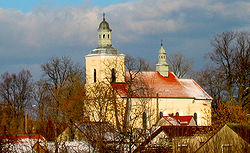
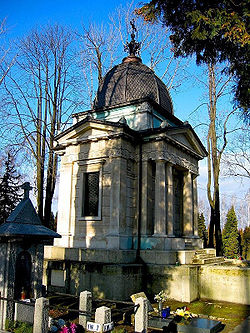
- Church of St Nicholas, most probably constructed at the turn of the 13th/14th century Its final architectural shape - as it then seemed, as it survived only until 1912 - had been created in the 15th century and shortly afterwards by adding annexes. A detached belfry was erected next to the church most probably around the same time. The present church was created by extensive reconstruction in 1912-1914. The interior decoration consist of several interesting altars with old paintings, arrestingly beautiful stained glass windows from 1914, grand chandelier from the 1930s and many other interesting historic objects.
- The Loewenfeld Mausoleum, built in 1898-1900 in Neo-Classical style on the Greek cross plan, according to a design of Teodor Talowski from Kraków. The chapel was raised as the mausoleum of the last owners of Chrzanów, the Loewenfelds.
- Market Square with residences from the late 18th and 19th centuries. Probably the most interesting of those is a 1905-1907 two-storey, Art-Nouveau house at nr 13 (previously nr 22). It has a façade of glazed bricks opulently decorated with miscellaneous ornaments (mostly chestnut foliage).
- The Victory and Liberty Monument at the Tysiąclecia Sq. (locally known as "The Eagle") by the Chrzanovian sculptor Marian Konarski. It was raised in 1971 in memory of the residents of Chrzanów who fell during World War II.
- The castle granary from the 16th century, now the seat of the Chrzanów Museum. The building was originally a part of the manor assembly (called the Castle), which in turn was the residence of the owners of Chrzanów. Since 1960 the building has housed collections of the Chrzanów Museum, including mementos of the last owners, the Loewenfelds. The Museum has an interesting collections on local history divided into several sections.
- The Church of St John the Baptist in Kościelec had been built probably in the 14th c. in Gothic style and it was preserved as such until 1843/45 when a decision was made for a general reconstruction of the church due to its rather poor shape. Among other interesting furnishings of the church is the 19th century high altar and black Dębniki marble epitaphs of the former owners of Kościelec, which until the recent renovation used to be on the walls of the presbytery. The church has a richly adorned bell of 1484.
- The Building of the Credit Society (1895) in Henry Avenue, with rich eclectic details including two porches with column porticos which make the whole structure look quite handsome.
- The Jewish cemetery (c. 1763) with 19th and 20th century tombstones. Initially it had consisted of two cemeteries, the small one (which was destroyed by the Germans in 1941) and the big one which has been preserved down to our own days (small part of which, however, was destroyed by the Germans during World War II).
Flag and coat of arms
The ancient coat of arms of Chrzanów, the St Nicholas, was created perhaps in the 14th century simultaneously with granting the Magdeburg Rights to Chrzanów. The oldest preserved seals of the town of Chrzanów are charged with an effigy of St Nicholas, the patron-saint of the local church, who holds a crosier in his right hand and a book in his left and wears bishop’s vestments and a bishop’s mitre on his head. Next to St Nicholas the Półkozic crest is seen which was the arms of the Ligęza Family, the former owners of Chrzanów. This coat of arms had been used by the town until c. 1809, when the authorities of the Duchy of WarsawDuchy of Warsaw
The Duchy of Warsaw was a Polish state established by Napoleon I in 1807 from the Polish lands ceded by the Kingdom of Prussia under the terms of the Treaties of Tilsit. The duchy was held in personal union by one of Napoleon's allies, King Frederick Augustus I of Saxony...
to which Chrzanów belonged to then, annulled all municipal coats-of-arms. Following the fall of the Duchy of Warsaw (1815) the arms of the Duchy was adopted as the arms of Chrzanów. It is unclear why the ancient and traditional arms were not restored. The arms of the Duchy of Warsaw, adopted after 1815 as the arms of Chrzanów, were a shield divided in half and placed under a royal crown. In the right field of the shield were the arms of Saxony
Saxony
The Free State of Saxony is a landlocked state of Germany, contingent with Brandenburg, Saxony Anhalt, Thuringia, Bavaria, the Czech Republic and Poland. It is the tenth-largest German state in area, with of Germany's sixteen states....
(black and golden stripes divided by a green crown-shaped half-wreath). In the left field were the coat of arms of Poland
Coat of arms of Poland
The White Eagle is the national coat of arms of Poland. It is a stylized white eagle with a golden beak and talons, and wearing a golden crown, in a red shield.- Legal basis :...
.
In 1964 the flag of Chrzanów was adopted. During the session of the City Council on 21 May 1964 it was decided that the city colours would be blue and red put in two horizontal stripes, exactly as the coulous of the Polish national flag. It seems quite probable that the choice of colours had been determined by the dominant colours in the old arms of Chrzanów featuring St Nicholas, and that is why such colours were adopted. In 2009 a new flag of Chrzanów was introduced. It consists of 3 vertical stripes: a broad white one, centrally located and featuring the city's arms and two narrower pale blue stripes flanking the central stripe on both sides.
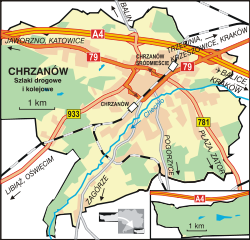
Kraków
Kraków also Krakow, or Cracow , is the second largest and one of the oldest cities in Poland. Situated on the Vistula River in the Lesser Poland region, the city dates back to the 7th century. Kraków has traditionally been one of the leading centres of Polish academic, cultural, and artistic life...
(to the east) and Katowice
Katowice
Katowice is a city in Silesia in southern Poland, on the Kłodnica and Rawa rivers . Katowice is located in the Silesian Highlands, about north of the Silesian Beskids and about southeast of the Sudetes Mountains.It is the central district of the Upper Silesian Metropolis, with a population of 2...
(to the west) via the A4 highway
Autostrada A4 (Poland)
The autostrada A4 in Poland is a motorway which runs from west to east through southern Poland, from the Polish-German border in Zgorzelec , through Wrocław, Katowice, Kraków, Tarnów, and Rzeszów to the Polish-Ukrainian border at Korczowa. The motorway is a part of the European route E40...
or via the national road
National roads in Poland
National road in Poland refers to a public trunk road controlled by the Polish central government authority, the General Directorship of National Roads and Motorways...
number 79.
Transport
There are also two voivodeship roads starting from Chrzanów: road number 933 (going south-west) to OświęcimOswiecim
Oświęcim is a town in the Lesser Poland province of southern Poland, situated west of Kraków, near the confluence of the rivers Vistula and Soła.- History :...
, Pszczyna
Pszczyna
Pszczyna is a town in southern Poland with 26,827 inhabitants within the immediate gmina rising to 50,121 inhabitants in the powiat, which includes the town of Pszczyna, itself, Brzeźce , Czarków , Ćwiklice , Jankowice , Łąka , Piasek , Poręba , Rudołtowice , Studzionka , Studzienice , Wisła...
and Jastrzębie-Zdrój and road number 781 (going south-east) to Andrychów
Andrychów
Andrychów is the largest town in Wadowice County in southern Poland with 22,257 inhabitants as of 2006. It has been situated in the Lesser Poland Voivodeship since 1999. Previously, it was located in Bielsko-Biała Voivodeship...
.
Rail connection links Chrzanów to Kraków (to the east), Oświęcim and Czechowice-Dziedzice
Czechowice-Dziedzice
Czechowice-Dziedzice is a town in Bielsko County, Silesian Voivodeship, southern Poland with 34,867 inhabitants . It lies on the northeastern edge of the historical region of Cieszyn Silesia...
(south-west). There are two rail stops in the town.
Education
Chrzanów has, among others, seven primary schools, two secondary schools, a secondary technical school, a music school and the Academy of Business and Marketing (Wyższa Szkoła Przedsiębiorczości i Marketingu).Notable people
- Ignacy SchwarzbartIgnacy SchwarzbartIgnacy Schwarzbart was a prominent Polish Zionist, and one of two Jewish representatives on the Polish National Council of the Polish Government-in-Exile during the Second World War, along with Szmul Zygielbojm....
(1888–1961), Zionist, member of the National Council of the Republic of Poland - Klemens Stefan SieleckiKlemens Stefan SieleckiKlemens Stefan Sielecki was a Polish engineer and technical director of the first Polish Locomotive Factory Fablok in Chrzanów in the post-war years until 1964....
(1903–1980), technical director of Fablok - Zbigniew Wąsiel (born 1966), sculptor
- Janusz SzromJanusz SzromJanusz Szrom is a Polish jazz vocalist and composer.His musical education started in 1977 on the piano, at Nysa School of Music. Then, in 1981, he started to play on trumpet while continuing to perfect the piano skills, in Chrzanów School of Music...
(born 1968), jazz singer - Michał Gajownik (1981–2009), Olympic canoeist
Twin towns — Sister cities
Chrzanów is twinnedTown twinning
Twin towns and sister cities are two of many terms used to describe the cooperative agreements between towns, cities, and even counties in geographically and politically distinct areas to promote cultural and commercial ties.- Terminology :...
with: Harnes
Harnes
Harnes is a commune in the Pas-de-Calais department in the Nord-Pas-de-Calais region of France.-Geography:Harnes is an ex-coalmining and light industrial town situated some northeast of Lens, at the junction of the D162e and the D39...
, France
France
The French Republic , The French Republic , The French Republic , (commonly known as France , is a unitary semi-presidential republic in Western Europe with several overseas territories and islands located on other continents and in the Indian, Pacific, and Atlantic oceans. Metropolitan France...
Nyékládháza
Nyékládháza
Nyékládháza is a small town in Borsod-Abaúj-Zemplén county, northern Hungary, 20 kilometers from county capital Miskolc.-History:The area has been inhabited since ancient times; archaeological finds include an Avar cemetery...
, Hungary
Hungary
Hungary , officially the Republic of Hungary , is a landlocked country in Central Europe. It is situated in the Carpathian Basin and is bordered by Slovakia to the north, Ukraine and Romania to the east, Serbia and Croatia to the south, Slovenia to the southwest and Austria to the west. The...
Ivano-Frankivsk
Ivano-Frankivsk
Ivano-Frankivsk is a historic city located in the western Ukraine. It is the administrative centre of the Ivano-Frankivsk Oblast , and is designated as its own separate raion within the oblast, municipality....
, Ukraine
Ukraine
Ukraine is a country in Eastern Europe. It has an area of 603,628 km², making it the second largest contiguous country on the European continent, after Russia...
External links
- Chrzanovia Patria Parva - a website on Chrzanów in English
- Chrzanow; the Life and Destruction of a Jewish Shtetl

